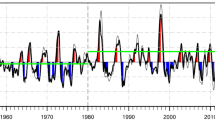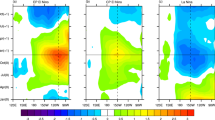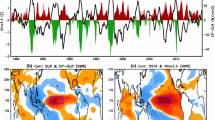Abstract
Observed oceanic and atmospheric anomalies in the tropical Pacific are analyzed to understand the symmetric and asymmetric characteristics between El Niño and La Niña evolutions. It is noted that the evolutions are largely symmetric for El Niño and La Niña prior to and in their mature phase, but become asymmetric afterwards. It is further demonstrated that this asymmetry is due to the fact that, on average, the discharge process associated with El Niño is stronger than the recharge counterpart associated with La Niña. The symmetric and asymmetric evolution for different phases of El Niño-Southern Oscillation (ENSO) is consistent with the associated recharge and discharge processes that are linked with the evolution of anomalous ocean surface current and gradient of sea surface height anomalies (SSHAs). It is suggested that the evolution of the meridional gradient of SSHAs in the central and eastern equatorial Pacific is different between El Niño and La Niña years due to relatively different rates of the SSHA changes on and off the equator. During the decay of a warm event, the equatorial SSHA quickly switches from positive to negative, meanwhile the off-equator areas are occupied by positive SSHAs. Such changes on the equator and in the off-equatorial regions make the concavity of the meridional SSHA favorable for growth and persistence of westward surface zonal current anomaly in the equatorial Pacific, then for the ENSO phase transition. During the decay of a cold event, the slow decrease of the negative SSHA on the equator combined with the disappearance of the negative SSHA in the off-equatorial regions makes the meridional concavity reverse easily and is unfavorable for the steady growth of the eastward surface zonal current anomaly and for the phase transition. Thus, the asymmetric evolution of ENSO is associated with both the atmosphere and ocean anomalies on the equator and off the equator.






Similar content being viewed by others
References
Alexander MA, Vimont DJ, Chang P, Scott JD (2010) The Impact of extratropical atmospheric variability on ENSO: testing the seasonal footprinting mechanism using coupled model experiments. J Clim 23:2885–2901. doi:10.1175/2010JCLI3205.1
An S-I, Jin F-F (2001) Collective role of zonal advective and thermocline feedbacks in ENSO mode. J Clim 14:3421–3432
An S-I, Jin F-F (2004) Nonlinearity and asymmetry of ENSO. J Clim 17:2399–2412
Anderson BT, Furtado JC, Cobb KM, Di Lorenzo E (2013) Extratropical forcing of El Niño/Southern Oscillation asymmetry. Geophys Res Lett 40:4916–4921. doi:10.1002/grl.50951
Barnston AG, Chelliah M, Goldenberg SB (1997) Documentation of a highly ENSO-related SST region in the equatorial Pacific. Atmos Ocean 35:367–383
Battisti DS, Hirst AC (1989) Interannual variability in a tropical atmosphere–ocean model: Influence of the basic state, ocean geometry and nonlinearity. J Atmos Sci 46:1687–1712
Behringer DW, Xue Y (2004) Evaluation of the global ocean data assimilation system at NCEP: the Pacific Ocean. preprints, eighth symposium on integrated observing and assimilation systems for atmosphere, oceans, and land surface, American Meteor Society, Seattle
Bejarano L, Jin F-F (2008) Coexistence of equatorial coupled modes of ENSO. J Clim 21:3051–3067. doi:10.1175/2007JCLI1679.1
Bjerknes J (1969) Atmospheric teleconnections from the equatorial Pacific. Mon Weather Rev 97:163–172
Chen H-C, Hu Z-Z, Huang B, Sui C-H (2016) The role of reversed equatorial zonal transport in terminating an ENSO event. J Clim 29(16):5859–5877. doi:10.1175/JCLI-D-16-0047.1
Choi K, Vecchi G, Wittenberg A (2013) ENSO transition, duration and amplitude asymmetries: Role of the nonlinear wind stress coupling in a conceptual model. J Clim 26:9462–9476. doi:10.1175/JCLI-D-13-00045.1
Clarke AJ, Van Gorder S, Colantuono G (2007) Wind stress curl and ENSO discharge/recharge in the equatorial Pacific. J Phys Ocean 37(4):1077–1091
DiNezio P, Deser C (2014) Nonlinear controls on the persistence of La Niña. J Clim 27(19):7335–7355. doi:10.1175/JCLI-D-14-00033.1
Hoerling M, Kumar A, Zhong M (1997) El Niño, La Niña, and the nonlinearity of their teleconnections. J Clim 10:1769–1786
Hu Z-Z, Kumar A, Xue Y, Jha B (2014) Why were some La Niñas followed by another La Niña? Clim Dyn 42(3–4):1029–1042. doi:10.1007/s00382-013-1917-3
Hu Z-Z, Kumar A, Huang B (2016) Spatial distribution and the interdecadal change of leading modes of heat budget of the mixed-layer in the tropical Pacific and the association with ENSO. Clim Dyn 46(5–6):1753–1768. doi:10.1007/s00382-015-2672-4
Hu Z-Z, Kumar A, Huang B, Zhu J, Ren H-L (2017) Interdecadal variations of ENSO around 1999/2000. J Meteor Res (published online). doi:10.1007/s13351-017-6074-x
Huang B, Xue Y, Zhang D, Kumar A, McPhaden MJ (2010) The NCEP GODAS ocean analysis of the tropical Pacific mixed layer heat budget on seasonal to interannual time scales. J Clim 23:4901–4925
Jin F-F (1997a) An equatorial ocean recharge paradigm for ENSO. Part I: conceptual model. J Atmos Sci 54:811–829
Jin F-F (1997b) An equatorial ocean recharge paradigm for ENSO. Part II: a stripped-down coupled model. J Atmos Sci 54:830–847
Jin F-F, An S-I (1999) Thermocline and zonal advective feedbacks within the equatorial ocean recharge oscillator model for ENSO. J Geophys Res 26:2989–2992
Jin F-F, Kug J, An S-I (2003) A near-annual coupled mode in the equatorial Pacific Ocean. Geophys Res Lett 30:1080. doi:10.1029/2002GL015983
Kessler WS (2002) Is ENSO a cycle or a series of events? Geophys Res Lett 29(23):2125. doi:10.1029/2002GL015924
Kim ST, Yu J-Y, Kumar A, Wang H (2012) Examination of the two types of ENSO in the NCEP CFS model and its extratropical associations. Mon Weather Rev 140:1908–1923. doi:10.1175/MWR-D-11-00300.1
Kug J-S, An S-I, Jin F-F, Kang I-S (2005) Preconditions for El Niño and La Niña onsets and their relation to the Indian Ocean. Geophys Res Lett 32:L05706. doi:10.1029/2004GL021674
Kumar A, Hoerling MP (1997) Interpretation and implications of observed inter-El Niño variability. J Clim 10:83–91
Kumar A, Hu Z-Z (2014) Interannual variability of ocean temperature along the equatorial Pacific in conjunction with ENSO. Clim Dyn 42(5–6):1243–1258. doi:10.1007/s00382-013-1721-0
Lloyd J, Guilyardi E, Weller H, Slingo J (2009) The role of atmosphere feedbacks during ENSO in the CMIP3 models. Atmos Sci Lett 10:170–176
McGregor S, Ramesh N, Spence P, England MH, McPhaden MJ, Santoso A (2013) Meridional movement of wind anomalies during ENSO events and their role in event termination. Geophys Res Lett 40:749–754. doi:10.1002/grl.50136
McPhaden MJ, Zhang X (2009) Asymmetry in zonal phase propagation of ENSO sea surface temperature anomalies. Geophys Res Lett 36:L13703. doi:10.1029/2009GL038774
Meinen CS, McPhaden MJ (2000) Observations of warm water volume changes in the equatorial Pacific and their relationship to El Niño and La Niña. J Clim 13:3551–3559
Ohba M, Ueda H (2009) Role of nonlinear atmospheric response to SST on the asymmetric transition process of ENSO. J Clim 22:177–192
Okumura YM, Ohba M, Deser C, Ueda H (2011) A proposed mechanism for the asymmetric duration of El Niño and La Niña. J Clim 24:3822–3829. doi:10.1175/2011JCLI3999.1
Philander SGH (1990) El Niño, La Niña and the Southern Oscillation. Academic Press, San Diego, p 293 (ISBN 0125532350)
Picaut J, Masia F, du Penhoat Y (1997) An advective-reflective conceptual model for the oscillatory nature of ENSO. Science 277:663–666
Ren H, Jin F-F (2013) Recharge oscillator mechanisms in two types of ENSO. J Clim 26:6506–6523. doi:10.1175/JCLI-D-12-00601.1
Ren H-L, Zuo J, Jin F-F, Stuecker MF (2016) ENSO and annual cycle interaction: the combination mode representation in CMIP5 models. Clim Dyn 46:3753–3765. doi:10.1007/s00382-015-2802-z
Reynolds RW, Rayner NA, Smith TM, Stokes DC, Wang W (2002) An improved in situ and satellite SST analysis for climate. J Clim 15:1609–1625
Sarachik ES, Cane MA (2010) The El Niño-Southern Oscillation Phenomenon. Cambridge University Press, London, p 384
Stuecker MF, Timmermann A, Jin F-F, McGregor S, Ren H-L (2013) A combination mode of the annual cycle and the El Niño/Southern Oscillation. Nat Geosci 6:540–544. doi:10.1038/ngeo1826
Suarez MJ, Schopf PS (1988) A delayed action oscillator for ENSO. J Atmos Sci 45:3283–3287
Wang C (2001) A unified oscillator model for the El Niño-Southern Oscillation. J Clim 14:98–115
Wyrtki K (1985) Water displacements in the Pacific and the genesis of El Niño cycles. J Geophys Res 90(C4):7129–7132
Yu J-Y, Kim ST (2011) Reversed spatial asymmetries between El Niño and La Niña and their linkage to decadal ENSO modulation in CMIP3 models. J Clim 24:5423–5434. doi:10.1175/JCLI-D-11-00024.1
Zhang R-H, Rothstein LM, Busalacchi AJ (1999) Interannual and decadal variability of the subsurface thermal structure in the Pacific Ocean: 1961–1990. Clim Dyn 15:703–717
Zhang Q, Kumar A, Xue Y, Wang W, Jin F-F (2007) Analysis of ENSO cycle in NCEP coupled forecast model. J Clim 20:1265–1284
Zhang W-J, Li J-P, Jin F-F (2009) Spatial and temporal features of ENSO meridional scales. Geophys Res Lett 36:L15605. doi:10.1029/2009GL038672
Acknowledgements
Authors appreciate the constructive comments of two reviewers as well as Dr. Peitao Peng and Prof. Raghu Murtugudde. Zhang is supported by the IOCAS through the CAS Strategic Priority Project [the Western Pacific Ocean System (WPOS)] and the NSFC-Shandong Joint Fund for Marine Science Research Center (Grant No. U1406401). Huang is supported by grants from NSF (ATM-0830068), NOAA (NA09OAR4310058), and NASA (NNX09AN50G). All data for this paper are available at NOAA Climate Prediction Center (CPC) and National Climate Data Center (NCDC), (http://www.cpc.ncep.noaa.gov/products/GODAS/; http://nomads.ncdc.noaa.gov/data.php?name=access#cfs). The scientific results and conclusions, as well as any view or opinions expressed herein, are those of the authors and do not necessarily reflect the views of NWS, NOAA, or the Department of Commerce.
Author information
Authors and Affiliations
Corresponding author
Rights and permissions
About this article
Cite this article
Hu, ZZ., Kumar, A., Huang, B. et al. Asymmetric evolution of El Niño and La Niña: the recharge/discharge processes and role of the off-equatorial sea surface height anomaly. Clim Dyn 49, 2737–2748 (2017). https://doi.org/10.1007/s00382-016-3498-4
Received:
Accepted:
Published:
Issue Date:
DOI: https://doi.org/10.1007/s00382-016-3498-4




